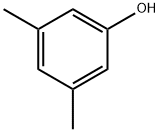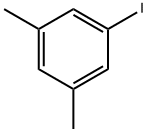Description
3,5-Dimethylphenol was used in simultaneous determination of urinary concentrations of phenol, o-, p-, m-cresols, 1-, 2-naphthol and xylenol isomers by capillary gas chromatography. It was used as starting reagent for total synthesis of landomycin A, most potent antitumor angucycline antibiotic and optically active polypropionate units. It also finds application as adhesives, sealant chemicals, plating and surface treating agents. It is also used as a solvent for cleaning or degreasing. Further, it is employed as a chemical intermediate for antioxidants, phenolic resins, active pharmaceutical ingredients and metaxalone (muscle relaxant).
Description
3,5-Xylenol is a crystalline solid. Molecularweight 5 122.17; Boiling point= 220℃ (sublimes);Freezing/Melting point=64℃; Flash point = 109℃.Soluble in water. Hazard Identification (based on NFPA-704 M Rating System): Health 3, Flammability 2, Reactivity0. Slightly soluble in water; solubility =0.5%.
Chemical Properties
3,5-Xylenol is a crystalline solid.
Uses
3,5-Dimethylphenol finds application as adhesives, sealant chemicals, plating and surface treating agents. It is also used as a solvent for cleaning or degreasing. Further, it is employed as a chemical intermediate for antioxidants, phenolic resins, active pharmaceutical ingredients and metaxalone (muscle relaxant).
Definition
ChEBI: A member of the class of phenols that phenol substituted by methyl groups at positions 3 and 5.
General Description
Colorless to off-white crystalline solid. Odor threshold 1 ppm. Taste threshold 0.001 mg/L.
Air & Water Reactions
3,5-Dimethylphenol is hygroscopic. Insoluble in water.
Reactivity Profile
3,5-Dimethylphenol is incompatible with bases, acid chlorides, acid anhydrides, and oxidizing agents. 3,5-Dimethylphenol corrodes steel, brass, copper, and copper alloys.
Fire Hazard
Flash point data for 3,5-Dimethylphenol are not available. 3,5-Dimethylphenol is probably combustible.
Safety Profile
Poison by
intraperitoneal route. Moderately toxic by
ingestion. A severe eye irritant. Questionable
carcinogen with experimental tumorigenic
data. When heated to decomposition it
emits acrid smoke and irritating fumes. See
also other xylenol entries.
Potential Exposure
3,5-Xylenol is used as an antioxidant,
solvent, plasticizer, wetting agent; and in pharmaceuticals.
Xylenols are also used in pesticides, fuel, and lubricant
additives; as a rubber chemical; in dyestuff manufacture.
There are actually six xylenol isomers.
First aid
Get medical attention at once following exposureto this compound.Inhalation: Remove patient immediately to fresh air; irritation of nose or throat may be somewhat relieved by spraying or gargling with water until all odor is gone; 100%oxygen inhalation is indicated for cyanosis or respiratorydistress; keep patient warm but not hot.Eyes: Flood with running water for 15 min; if physician isnot immediately available, continue irrigation for another15 min; 2-3 drops of 0.5% pontocaine or equivalent maybe instilled after first 15 min; do not use oils or oily ointments unless ordered by physician.Skin: Wash affected areas with large quantities of water orsoapy water until all odor is gone; then wash with alcoholor 20% glycerin solution and more water; keep patientwarm but not hot; cover chemical burns continuously withcompresses wet with saturated solution of sodium thiosulfate; apply no salves or ointments for 24 h after injury.Ingestion: Give large quantities of liquid (saltwater, weaksodium bicarbonate solution, milk, or gruel) followed bydemulcent, such as raw egg white or corn starch paste; ifprofuse vomiting does not follow immediately, give a mildemetic (such as 1 tablespoon of mustard in glass of water)or tickle back of throat. Repeat procedure until vomitus isfree of the odor. Some demulcent should be left in stomachafter vomiting. Keep patient comfortably warm.
storage
Color Code—Blue: Health Hazard/Poison: Storein a secure poison location. Prior to working with thischemical you should be trained on its proper handling andstorage. Store in tightly closed containers in a cool, wellventilated area away from chemical oxidizers. Sources ofignition, such as smoking and open flames, are prohibitedwhere xylenols is used, handled, or stored in a manner thatcould create a potential fire or explosion hazard.
Shipping
UN 2261 Xylenols, Hazard Class: 6.1; Labels:
6.1-Poisonous materials.
Purification Methods
Purify it as for 3,4-dimethylphenol. [Beilstein 6 IV 3141.]
Incompatibilities
A weak organic acid. Incompatible with
oxidizers (chlorates, nitrates, peroxides, permanganates,
perchlorates, chlorine, bromine, fluorine, etc.); contact may
cause fires or explosions. Keep away from alkaline materials,
strong bases, strong acids, oxoacids, and epoxides.
Toxics Screening Level
The initial threshold screening level for 3,5-dimethylphenol is being set at 0.8 μg/m3 with annual averaging.
Waste Disposal
Dissolve or mix the material
with a combustible solvent and burn in a chemical incinerator
equipped with an afterburner and scrubber. All federal, state,
and local environmental regulations must be observed.






